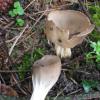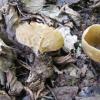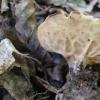
08-11-2025 00:29
 Francois Guay
Francois Guay
I found this species in Quebec, Canada, on herbace

04-11-2025 09:07
Hello.A suspected Hymenoscyphus sprouting on a thi

04-11-2025 12:43
 Edvin Johannesen
Edvin Johannesen
Hi! One more found on old Populus tremula log in O

03-11-2025 21:34
 Edvin Johannesen
Edvin Johannesen
These tiny (0.4-0.5 mm diam.), whitish, short-stip

28-10-2025 15:37
Carl FarmerI'd be grateful for any suggestions for this strik

03-11-2025 16:30
 Hans-Otto Baral
Hans-Otto Baral
Hello I want to ask you if you have found this ye
Helvella acetabulum
Alain GARDIENNET,
02-05-2012 15:11
Juste une question concernant cette espèce. Quelle est la fourchette des dimensions sporales acceptées pour H. acetabulum ?
J'avoue que d'un auteur à un autre, j'ai du mal à m'y retrouver.
Alain
Martin Bemmann,
02-05-2012 20:01

Re : Helvella acetabulum
Hi Alain,
I start with three data sets I found quickly within my files:
Dissing 1966: 16-17.7-19 x 11-11.8-12 µm
Kaushal 1991: 16-20 x 10.5-13 µm
Abbot&Currah 1997: 16-20 x 11-13.7 µm
Best regards
Martin
I start with three data sets I found quickly within my files:
Dissing 1966: 16-17.7-19 x 11-11.8-12 µm
Kaushal 1991: 16-20 x 10.5-13 µm
Abbot&Currah 1997: 16-20 x 11-13.7 µm
Best regards
Martin
Alain GARDIENNET,
03-05-2012 11:47
Nicolas VAN VOOREN,
03-05-2012 19:24

Re : Helvella acetabulum
Salut Alain.
A partir de mes récoltes, matériel frais, j'ai une amplitude de spores de (17) 18-22 x (12) 13-14.5 (15) µm.
Sur ta photo, la couleur semble plus tirer sur le gris que sur le brun, ce qui pourrait correspondre à H. costifera, mais les cotes ne me paraissent pas assez proéminentes.
A partir de mes récoltes, matériel frais, j'ai une amplitude de spores de (17) 18-22 x (12) 13-14.5 (15) µm.
Sur ta photo, la couleur semble plus tirer sur le gris que sur le brun, ce qui pourrait correspondre à H. costifera, mais les cotes ne me paraissent pas assez proéminentes.
Alain GARDIENNET,
03-05-2012 19:36
Re : Helvella acetabulum
Salut Nicolas,
J'ai pris cette photo sous un parapluie hier alors qu'il tombait des hallebardes, les couleurs sont plus sombres qu'en réalité où mon helvelle montre une belle teinte brune.
Par ailleurs, la largeur de 15 µm n'a été observée que pour deux spores sur 30 mesurées (j'aurais dû le signaler en mettant cette mesure entre parenthèses). Les autres largeurs sont principalement dans la fourchette 14,2-14,5 µm. A partir de ces éléments et grâce à tes observations, je pense qu'il s'agit bien de H. acetabulum, n'est-ce-pas ?
Merci,
Alain
J'ai pris cette photo sous un parapluie hier alors qu'il tombait des hallebardes, les couleurs sont plus sombres qu'en réalité où mon helvelle montre une belle teinte brune.
Par ailleurs, la largeur de 15 µm n'a été observée que pour deux spores sur 30 mesurées (j'aurais dû le signaler en mettant cette mesure entre parenthèses). Les autres largeurs sont principalement dans la fourchette 14,2-14,5 µm. A partir de ces éléments et grâce à tes observations, je pense qu'il s'agit bien de H. acetabulum, n'est-ce-pas ?
Merci,
Alain
Martin Bemmann,
03-05-2012 20:05

Re : Helvella acetabulum
Hi Alain,
I think with some more research you will find a broader range of spore measurements. Just as an example: Boudier (Icones IV, 129f.) gives 22-24 x 14-15 µm for Acetabula vulgaris as it was named in his time.
Regards,
Martin
I think with some more research you will find a broader range of spore measurements. Just as an example: Boudier (Icones IV, 129f.) gives 22-24 x 14-15 µm for Acetabula vulgaris as it was named in his time.
Regards,
Martin
Neven Matocec,
04-05-2012 11:14

Re : Helvella acetabulum
Hi Alain, hi all!
Sorry that I didn't answer more promptly but we had 8 days session of giving mycological course with a plenty of fieldwork in rather remote areas!
So, I'd just like to add that H. acetabulum is, especially in spores, quite variable. But also there is general warning regarding data sets of living versus dead structures. In Pezizales this is particularly valid for spore diameter.
Nevertheless, about 20 of my treated H. acetabulum in the living state produced spores in range about 17,5-20,5 × 13-14 up to 20-22 × 14-15 micr. but without any apparent clearcuts between geographical/ecological "populations". I could only conclude that larger spores were produced in warmer bioclimates: i.e. mesomediterranean zone (evergreen to mixed forests) gave higest values as I mentioned above, submediterranean (thermophilic deciduous forests) and mesophilic-mediterranoid continental areas intermediate values, while mesophilic deciduous forests (continental plains to submontane zone) gave the lowest values I mentioned above.
Can you tell me Alain just roughly about geographic position of your collection?
Cheers,
Neven
Sorry that I didn't answer more promptly but we had 8 days session of giving mycological course with a plenty of fieldwork in rather remote areas!
So, I'd just like to add that H. acetabulum is, especially in spores, quite variable. But also there is general warning regarding data sets of living versus dead structures. In Pezizales this is particularly valid for spore diameter.
Nevertheless, about 20 of my treated H. acetabulum in the living state produced spores in range about 17,5-20,5 × 13-14 up to 20-22 × 14-15 micr. but without any apparent clearcuts between geographical/ecological "populations". I could only conclude that larger spores were produced in warmer bioclimates: i.e. mesomediterranean zone (evergreen to mixed forests) gave higest values as I mentioned above, submediterranean (thermophilic deciduous forests) and mesophilic-mediterranoid continental areas intermediate values, while mesophilic deciduous forests (continental plains to submontane zone) gave the lowest values I mentioned above.
Can you tell me Alain just roughly about geographic position of your collection?
Cheers,
Neven
Alain GARDIENNET,
04-05-2012 21:53
Re : Helvella acetabulum
Hi Neven,
It comes from Burgundy, exactly :
Gevrey-Chambertin (France, 21), Bois de Penecière, 47°13'20 N - 5°00'44 E, alt. 237m.
Alain
It comes from Burgundy, exactly :
Gevrey-Chambertin (France, 21), Bois de Penecière, 47°13'20 N - 5°00'44 E, alt. 237m.
Alain
Neven Matocec,
05-05-2012 09:50

Re : Helvella acetabulum
Hi Alain!
Oh! Thank you on precise data! Well, I just looked on nice doc. about European forest types (http://www.env-edu.gr/Documents/European%20forest%20types.pdf?) that I found on net rather recently and it seems that your broader spored H. acetabulum may have something to do with thin stripe of thermophilous mixed deciduous broadleaved forests charted in vicinity of Dijon that are comparable to our Continental mediterranoid forests I wrote in my last post!
Anyway, since I instantly discovered some errors on mentioned maps in view of some more detailed areas in the region south-easternward from the Alps - these map(s) are of course ment just for general, rough usage! So, a detailed vegetation map of France should be used instead but I don't have any.
Cheers,
Neven
Oh! Thank you on precise data! Well, I just looked on nice doc. about European forest types (http://www.env-edu.gr/Documents/European%20forest%20types.pdf?) that I found on net rather recently and it seems that your broader spored H. acetabulum may have something to do with thin stripe of thermophilous mixed deciduous broadleaved forests charted in vicinity of Dijon that are comparable to our Continental mediterranoid forests I wrote in my last post!
Anyway, since I instantly discovered some errors on mentioned maps in view of some more detailed areas in the region south-easternward from the Alps - these map(s) are of course ment just for general, rough usage! So, a detailed vegetation map of France should be used instead but I don't have any.
Cheers,
Neven
Alain GARDIENNET,
07-05-2012 09:07
Re : Helvella acetabulum
Hi Neven,
Yes, it was a thermophilous mixted deciduous broadleaved forest, as you said.
Yesterday, I found a second one, on calcareous soil of an hillside. Here are photos.
What do you think ? Could it be costifera this time ? It's smaller : stipe 1 cm high, cup 4cm broad for 2cm high.
Alain
Yes, it was a thermophilous mixted deciduous broadleaved forest, as you said.
Yesterday, I found a second one, on calcareous soil of an hillside. Here are photos.
What do you think ? Could it be costifera this time ? It's smaller : stipe 1 cm high, cup 4cm broad for 2cm high.
Alain
Alain GARDIENNET,
11-05-2012 22:01
Re : Helvella acetabulum
Taille des spores : 18-20 x 12.5-13.5 µm.
Très proche microscopiquement de la première helvelle.
Mais macroscopiquement, la différence est nette.
Toujours rien ?
Alain
Très proche microscopiquement de la première helvelle.
Mais macroscopiquement, la différence est nette.
Toujours rien ?
Alain
Yannick Mourgues,
11-05-2012 23:04

Re : Helvella acetabulum
Ben moi, j'en ferai bien une H. costifera celle-là ! Mais ce n'est que mon avis !
Yannick
Yannick
Alain GARDIENNET,
11-05-2012 23:23
Re : Helvella acetabulum
Ton avis est le bienvenu !
Neven Matocec,
12-05-2012 18:25

Re : Helvella acetabulum
Hi Alain,
I'm just back from fieldwork (I've been in very remote areas without much telecomunication options). I'll be back in lab on Monday so everything I now have on Helvellas is on my head!
All I can say at this moment is that your macropics present very unusual colours and reticulate blunt ribbed exterior. My H. costiferas are more steel greyish and ribbs could be only rarely subreticulate and only in fairly immature apothecia. Spores are in range of many Helvella spp. Anyway, your collection looks very intriguing!
Can you make an vertical section and the micorpics presenting outer excipulum with the pustules while you still have fresh material? Otherwise you may also send one submature apo if still in fresh condition.
Cheers,
Neven
I'm just back from fieldwork (I've been in very remote areas without much telecomunication options). I'll be back in lab on Monday so everything I now have on Helvellas is on my head!
All I can say at this moment is that your macropics present very unusual colours and reticulate blunt ribbed exterior. My H. costiferas are more steel greyish and ribbs could be only rarely subreticulate and only in fairly immature apothecia. Spores are in range of many Helvella spp. Anyway, your collection looks very intriguing!
Can you make an vertical section and the micorpics presenting outer excipulum with the pustules while you still have fresh material? Otherwise you may also send one submature apo if still in fresh condition.
Cheers,
Neven
Nicolas VAN VOOREN,
13-05-2012 22:38

Re : Helvella acetabulum
Je ne pense pas qu'on puisse interpréter cette deuxième collection comme H. costifera, cette dernière étant de couleur grise. Cette configuration en "réseau" des cotes est atypique pour H. acetabulum, mais je ne vois rien d'autre comme espèce.



